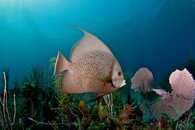raskous
Registered
Hey all
I've been shooting videos on my dives for a while now, with a gopro
But i feel it's time to get more control and image quality, so i've been looking at getting a canon T2i (550d) which seems to be the best one in my budget.
I've also been looking at lenses, and noticed that a bunch of websites about UW photography really love using fisheye lenses, especially the tokina 10-17 one.
I can understand that choice for pictures... but the thing is, the more i look at videos shot with a fisheye, the more i hate it, all i see is curved lines everywhere. It just looks cinematographically wrong to me, and just reminds me of teenagers shooting skate videos.
So i just wanted to know if you, video shooters, were also using fisheyes, and if so, what is the real advantage of using those vs a normal wide lens, what could be so good about it that it'd be worth having curved lines everywhere?
I've been looking at a bunch of TV UW documentaries, and for me, it doesn't look like they use fisheye (i could be wrong though, i'm not a pro), so it gets me wondering why dslr user focus so much on fisheyes.
Chris
I've been shooting videos on my dives for a while now, with a gopro
But i feel it's time to get more control and image quality, so i've been looking at getting a canon T2i (550d) which seems to be the best one in my budget.
I've also been looking at lenses, and noticed that a bunch of websites about UW photography really love using fisheye lenses, especially the tokina 10-17 one.
I can understand that choice for pictures... but the thing is, the more i look at videos shot with a fisheye, the more i hate it, all i see is curved lines everywhere. It just looks cinematographically wrong to me, and just reminds me of teenagers shooting skate videos.
So i just wanted to know if you, video shooters, were also using fisheyes, and if so, what is the real advantage of using those vs a normal wide lens, what could be so good about it that it'd be worth having curved lines everywhere?
I've been looking at a bunch of TV UW documentaries, and for me, it doesn't look like they use fisheye (i could be wrong though, i'm not a pro), so it gets me wondering why dslr user focus so much on fisheyes.
Chris




